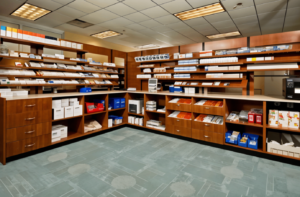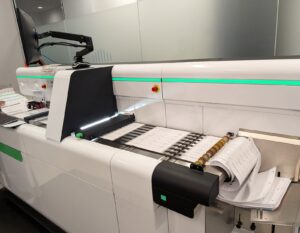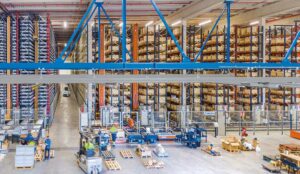Looking for ways to optimize and maximize your museum storage space? Finding efficient storage solutions is crucial for museums to properly preserve and protect their valuable collections. With limited physical space and the need to store a wide range of artifacts, it’s important to implement innovative strategies to maximize storage efficiency. In this blog, we will explore five clever ways to optimize museum storage space, from implementing space-saving shelving solutions to integrating technology for smarter collections management. By utilizing these techniques, museums can enhance accessibility, improve organization, and ensure the long-term preservation of their collections, making it easier to set up new exhibits and showcase their collections to the public. These strategies play an important role in maintaining the integrity and longevity of museum collections, making it possible for donors to contribute major gifts towards high-quality storage solutions.
5 Innovative Strategies to Enhance Museum Storage Efficiency
To optimize museum storage space, it’s essential to implement innovative strategies that enhance efficiency. By utilizing these strategies, museums can make the most of their storage area and ensure the long-term preservation of their collections. Here are five innovative ways to enhance museum storage efficiency.
Strategy 1. Implementing Space-Saving Shelving Solutions
Implementing space-saving shelving solutions is a key strategy to optimize museum storage space. By utilizing vertical space and maximizing storage area, museums can efficiently store and organize their collections. Here are some ways to implement space-saving shelving solutions:
- Utilize high-density compact shelving systems that maximize storage capacity by eliminating wasted aisle space.
- Install adjustable shelving units that can be customized to fit the specific needs of different artifacts and collections.
- Use mobile shelving systems that can be easily moved and reconfigured as needed, allowing for flexible storage arrangements.
- Incorporate sliding or rolling shelves that provide easy access to stored items while maximizing storage density.
Strategy 2. Utilizing Vertical Storage to Maximize Space
Vertical storage is a great way to maximize museum storage space. By utilizing the height of the storage area, museums can effectively store a larger number of artifacts while utilizing the same floor space. Here are some ways to utilize vertical storage in museums:
- Install tall museum cabinets that take advantage of the vertical space. These cabinets can have multiple shelves and compartments to store different types of artifacts.
- Utilize hanging storage systems, such as art storage racks, that can be mounted on walls or suspended from the ceiling. These racks provide vertical storage for artwork while keeping them easily accessible.
- Consider utilizing overhead storage systems, such as mezzanines or high bay storage, to create additional storage space above existing storage areas. These systems can be customized to fit the specific needs of the museum and provide a cost-effective solution for maximizing vertical storage.
Lorem ipsum dolor sit amet, consectetur adipiscing elit. Ut elit tellus, luctus nec ullamcorper mattis, pulvinar dapibus leo.
Strategy 3. Customizing Storage Units for Unique Artifact Needs
Customizing storage units for unique artifact needs is essential for optimizing museum storage space. Different types of artifacts require specific storage conditions and configurations to ensure their long-term preservation. Here are some ways to customize storage units for unique artifact needs:
- Install specialized storage racks for fragile or large items. These racks can be designed to provide proper support and protection for delicate artifacts.
- Use custom shelving that can be adjusted or modified to accommodate artifacts of different sizes and shapes.
- Consider incorporating climate-controlled storage units for sensitive items that require specific temperature and humidity conditions.
- Install storage units with adjustable compartments or drawers to accommodate artifacts of varying sizes.
Strategy 4. Adopting High-Density Storage Systems
Adopting high-density storage systems is a smart strategy to optimize museum storage space. These systems maximize the use of available storage area by minimizing wasted space and providing efficient storage solutions for museum collections. Here are some benefits of adopting high-density storage systems:
- Increased storage capacity: High-density storage systems, such as compact shelving or mobile storage systems, can significantly increase the storage capacity by eliminating wasted aisle space.
- Improved organization: High-density storage systems provide a systematic and organized approach to storing and retrieving artifacts, making it easier for museum staff to locate and access items.
- Better preservation: By reducing the need for excessive handling and movement of artifacts, high-density storage systems help minimize the risk of damage or deterioration.
- Flexibility and scalability: High-density storage systems can be easily expanded or reconfigured as the museum’s collection grows, providing a scalable storage solution.
Strategy 5. Integrating Technology for Smarter Collections Management
Integrating technology into museum storage solutions is crucial for smarter collections management. By leveraging digitalization and advanced systems, museums can streamline their storage processes, improve accessibility, and enhance collections care. Here are some ways to integrate technology for smarter collections management:
- Implement inventory management software that allows for digital cataloging and tracking of museum collections. This enables efficient organization and retrieval of stored artifacts.
- Utilize barcode or RFID tagging systems to easily identify and locate specific items within the storage area.
- Incorporate environmental monitoring systems that track temperature, humidity, and other environmental conditions to ensure the preservation of sensitive artifacts.
- Explore digital imaging and 3D scanning technologies to create digital replicas of artifacts, reducing the need for physical storage space while still allowing for study and research.
Maximizing Artifact Accessibility with Creative Layouts
Maximizing artifact accessibility is essential for museums to create vibrant community hubs and engage visitors. By designing creative layouts that promote easy navigation and visibility, museums can enhance the visitor experience and ensure that stored artifacts are easily accessible.
Designing User-Friendly Access Points
When designing museum storage layouts, it’s important to create user-friendly access points that allow for easy retrieval of artifacts. Here are some tips for designing user-friendly access points:
- Use clear signage and labeling systems to indicate the location of different artifact categories or collections.
- Incorporate well-lit areas and adequate lighting fixtures to ensure visibility and reduce the risk of accidents or damage to artifacts during retrieval.
- Consider installing sliding or rolling storage systems that provide easy access to stored items without the need for heavy lifting or reaching.
- Design storage areas with wide aisles and pathways to accommodate wheelchair accessibility and ease of movement for staff and visitors.
Crafting Flexible Display and Storage Areas
Creating flexible display and storage areas is key to optimizing museum storage space. By designing spaces that can adapt to changing exhibit needs and accommodate different types of artifacts, museums can maximize their storage efficiency. Here are some ways to craft flexible display and storage areas:
- Utilize modular display cases and shelving units that can be easily adjusted or reconfigured to accommodate different sizes and types of artifacts.
- Incorporate movable partitions or dividers that can create flexible storage spaces, allowing for easy rearrangement of artifacts as needed.
- Design storage areas with adjustable shelving or movable racks that can be expanded or contracted based on the size and quantity of artifacts being stored.
- Incorporate flexible display systems that allow for easy rotation or swapping of artifacts, creating dynamic exhibits that engage visitors.
Collections Management: Best Practices for Organization
Collections management and organization are crucial for museums to efficiently store and retrieve their artifacts. By implementing best practices for organization, museums can ensure the proper care and long-term preservation of their collections.
Streamlining Collection Inventories with Digital Tools
Digital tools can greatly streamline collection inventories and improve the organization of museum storage. Here are some ways to streamline collection inventories with digital tools:
- Implement inventory management software that allows for digital cataloging and tracking of museum collections. This eliminates the need for manual record-keeping and provides a centralized database for easy access to collection information.
- Utilize barcode or RFID tagging systems to digitally track and manage artifacts. This enables efficient inventory management and reduces the risk of human error.
- Explore digital imaging and 3D scanning technologies to create digital replicas of artifacts. This not only reduces the physical storage space required but also allows for virtual access and study of artifacts.
Implementing Efficient Retrieval Systems
Efficient retrieval systems are essential for optimizing museum storage space. By implementing systems that streamline the retrieval process, museums can save time and resources. Here are some ways to implement efficient retrieval systems:
- Organize artifacts based on frequency of use or thematic categories to ensure easy retrieval.
- Utilize barcode or RFID tagging systems to quickly locate and retrieve specific artifacts within the storage area.
- Implement a well-designed storage layout that minimizes the need for excessive movement or handling of artifacts during retrieval.
- Train staff on proper retrieval procedures and provide clear guidelines for artifact handling and movement.
Innovative Space-Saving Techniques for Museum Archives
Museum archives often face the challenge of limited storage space for preserving historical documents and records. Implementing innovative space-saving techniques is crucial for optimizing museum archives.
Exploring Off-Site Storage Options
Exploring off-site storage options is a practical solution for optimizing museum archives. Here are some benefits of off-site storage for museum archives:
- Increased storage capacity: Off-site storage facilities often offer larger storage spaces compared to on-site storage areas, allowing for the storage of a greater volume of archival materials.
- Secure storage environment: Off-site storage facilities are designed to provide optimal conditions for preserving delicate archival materials, such as controlled temperature and humidity levels.
- Cost-effective solution: Renting off-site storage space can be a cost-effective alternative to building or expanding on-site storage facilities.
- Enhanced preservation: Off-site storage facilities often have advanced security systems and disaster prevention measures in place, ensuring the long-term preservation of archival materials.
Leveraging Compact Storage Furniture
Leveraging compact storage furniture is a practical way to save space in museum archives. Here are some examples of compact storage furniture for museum archives:
| Compact Storage Furniture | Description |
| Rolling stackable bins | These bins can be stacked vertically to maximize storage space and easily rolled for convenient access to stored materials. |
| Mobile shelving units | Mobile shelving units can be compacted together to save space when not in use and expanded to create storage aisles when needed. |
| Pull-out drawers | Pull-out drawers provide easy access to stored materials while maximizing storage capacity in a compact footprint. |
| Wall-mounted storage racks | Wall-mounted storage racks are mounted on the walls to save floor space while providing vertical storage for documents and records. |
Tailoring Custom Shelving Solutions for Special Exhibits
Tailoring custom shelving solutions is essential for optimizing storage space for special exhibits in museums. By designing shelving systems that cater to the unique needs of specific exhibits, museums can maximize the display and storage capacity for these temporary installations.
Adjustable Shelving for Changing Display Needs
Using adjustable shelving is a smart solution for accommodating changing display needs in museums. Here are some benefits of using adjustable shelving for changing display needs:
- Flexibility: Adjustable shelving can be easily reconfigured or modified to accommodate different sizes and types of artifacts, allowing for a flexible display layout.
- Scalability: Adjustable shelving systems can be expanded or contracted based on the number of artifacts being displayed, providing scalability for changing exhibit needs.
- Customization: Adjustable shelving allows for the customization of display spaces, ensuring that artifacts are properly showcased and easily accessible.
- Space optimization: By utilizing adjustable shelving, museums can make the most of their storage area and maximize the number of artifacts that can be displayed within a limited space.
Specialized Racks for Fragile or Large Items
Using specialized racks for fragile or large items is crucial for optimizing museum storage space. Here are some examples of specialized racks for fragile or large items:
- Artwork cradles: Artwork cradles provide proper support and protection for delicate artworks, ensuring their stability during storage.
- Sculpture racks: Sculpture racks are designed to hold large, bulky sculptures securely while maximizing vertical space in the storage area.
- Textile racks: Textile racks are equipped with adjustable bars and supports to safely store delicate textiles and fabrics, preventing damage or distortion.
- Oversized artifact racks: Oversized artifact racks are specially designed to accommodate large artifacts, such as furniture or architectural elements, while optimizing storage space.






